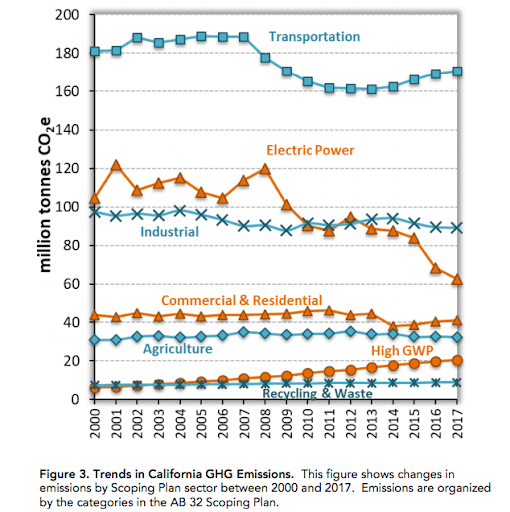Myth Of The Month: Cleaning Up The Power System Means Solving Global Warming
Oct 8, 2019
Image by Egor Shitikov from Pixabay.
Every day brings news of solar and wind power getting cheaper. Coal has fallen from half of US power supply to less than a third in the past decade. Emissions are plummeting in the power sector, helping in the fight against global warming.
California has been leading the transition, cutting power sector carbon emissions in half over the last decade. This progress inspired the legislature to expand the state clean energy mandate to 100 percent zero-carbon power supplies by 2045.
One Step Forward, Two Steps Back
But good news from the power sector is masking the lack of progress in other major areas.
The California Air Resources Board recently updated the California Greenhouse Gas Emission Inventory, with data through 2017. While power sector emissions continued to drop in 2017, by nine percent, overall emissions fell only one percent that year. Power sector gains were canceled by rising emissions from the transportation and buildings sectors.
The power sector now accounts for only 15 percent of state emissions, compared to 41 percent from transportation. If oil drilling and refineries are included, transportation amounts to about half of all state emissions.

Transportation emissions fell from 2007 to 2011, but have since started to rise, growing another one percent in 2017. While hybrid and electric cars are becoming more common, they are being outpaced by growing amounts of driving and the popularity of trucks, SUVs, and vans as passenger vehicles. New registrations of trucks outnumbered passenger cars in California for the first time in 2017.

Other sectors have seen little change in the past two decades. Carbon emissions from natural gas used in residential and commercial buildings are staying flat at 12 percent of the total. This is despite world-leading efforts to promote energy efficiency through building codes, appliance standards, and programs.
Clearly if California is going to solve the climate problem it will have to go beyond the power sector.
Cleaning Up Buildings And Cars
The key to cleaning up transportation and buildings is to use increasingly clean electricity — to “electrify everything.”
In buildings, most emissions come from natural gas used for space heating and water heating, with smaller amounts for cooking, laundry, and other uses. The key technology fix is the electric heat pump. While old heaters used electrical resistance to generate heat, heat pumps simply move heat around, vastly increasing their efficiency and cost effectiveness. Refrigerators and air conditioners are heat pumps, moving heat from inside a building or refrigerator to the outside. Heat pumps can replace gas furnaces and gas-fired water heaters.
For cooking, the latest electric technology is induction cooktops, which use magnetic waves to heat up pots and pans much more quickly and efficiently than resistance coils.
In July, Berkeley became the first city in the country to ban natural gas hookups for newly constructed housing. As described in another article in this issue, EBCE is working with member communities to educate the public and professionals about building electrification, and supporting efforts to reform building codes.
Cutting emissions from vehicles is the other priority. In 2018, Gov. Jerry Brown set a goal of 1.5 million zero-emission vehicles (ZEVs) to be on the road by 2025, and then 5 million by 2030. Alameda County’s share would be 80,000 ZEVs, and we are on our way with 27,000 currently.
EBCE is prioritizing vehicle electrification initiatives through its Local Development Business Plan. The first step is collaborating with local government partners on a Municipal Fleet Electrification Study that will enable cities to lead by example in the communities they serve. Electric fleets can deliver lower lifecycle costs and reduced fuel price risk, in addition to clean air.
To do the study, EBCE plans to hire a consultant to assess municipal fleet electrification opportunities and barriers for each participating local government. The study will also look at how EVs can be integrated with onsite renewables, battery energy storage, and managed charging systems, to reduce grid impacts.
A clean power system is good in its own right, but it can become a powerful tool in decarbonizing the rest of the economy. Clean local power, integrated with vehicles and buildings, can help save the planet even as we keep energy dollars in the community.